The Most Beautiful Varieties of Peony Flowers to Grow in Your Garden
Published: October 19, 2025 at 8:59:25 PM UTC
Peonies stand as the undisputed royalty of the spring garden, captivating gardeners with their lush blooms, intoxicating fragrance, and remarkable longevity. These magnificent perennials offer an unmatched display of beauty, with flowers often larger than your hand and a presence that transforms any garden space.
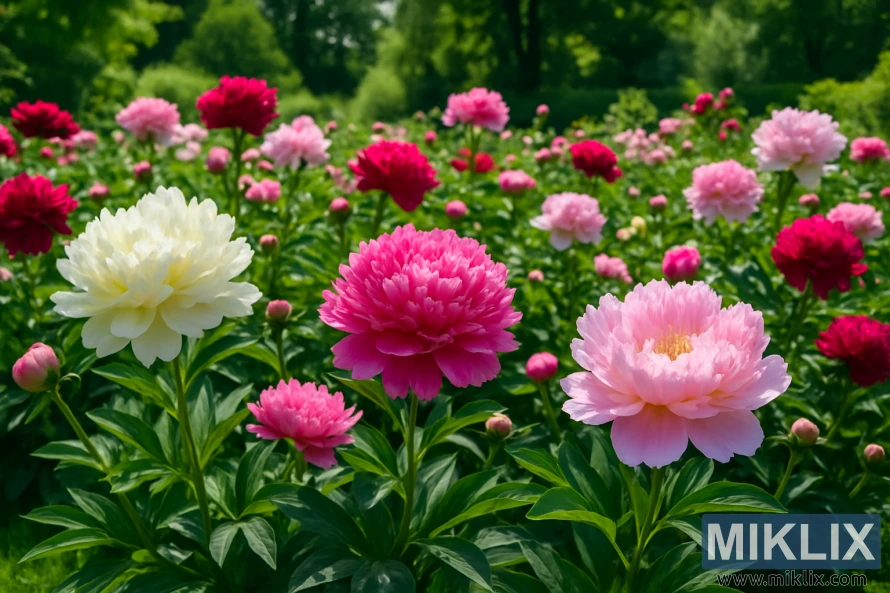
Whether you're drawn to the classic bowl of petals, the dramatic bomb-shaped blooms, or the delicate single forms, peonies reward gardeners with decades of reliable flowering and minimal maintenance.
In this guide, we'll explore the most stunning peony varieties available to home gardeners, from time-honored classics to remarkable modern hybrids. Each selection has been chosen not only for its exceptional beauty but also for its performance in garden settings. By understanding the unique characteristics and requirements of these gorgeous varieties, you'll be well-equipped to create a peony collection that brings joy and beauty to your garden year after year.
Understanding the Different Types of Beautiful Peony Varieties
Before diving into specific varieties, it's helpful to understand the three main types of peonies available to gardeners. Each type offers unique characteristics and beauty, allowing you to select the perfect peonies for your garden conditions and aesthetic preferences.
Herbaceous Peonies
The most common type, herbaceous peonies die back to the ground each winter and emerge with fresh growth in spring. They typically reach 2-4 feet in height and offer the widest range of colors and forms. These classic garden peonies are extremely long-lived, often outlasting their gardeners by decades.
- Bloom in late spring to early summer
- Die back completely in winter
- Extremely hardy (zones 3-8)
- Widest variety of colors and forms
Tree Peonies
Unlike their herbaceous cousins, tree peonies develop woody stems that remain above ground year-round. They grow slowly into shrub-like plants reaching 4-7 feet tall. Their flowers are typically larger than herbaceous varieties, often measuring 8-10 inches across, and come in stunning colors including true yellows and purples rarely found in herbaceous types.
- Bloom earlier than herbaceous types
- Woody stems remain year-round
- Slightly less cold-hardy (zones 4-9)
- Larger flowers and unique colors
Intersectional (Itoh) Peonies
These remarkable hybrids combine the best qualities of both herbaceous and tree peonies. Created by crossing the two types, Itoh peonies offer the magnificent flowers and color range of tree peonies on plants with the growth habit and hardiness of herbaceous types. They typically produce more blooms per plant than either parent type.
- Die back to ground like herbaceous types
- Produce up to 50+ blooms per mature plant
- Strong stems rarely need staking
- Extended bloom period
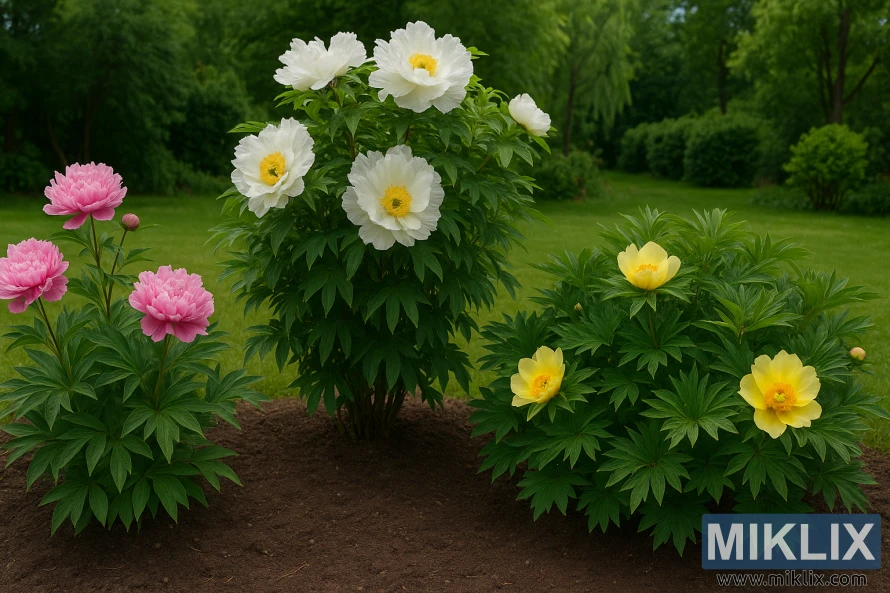
Most Beautiful Herbaceous Peony Varieties
Herbaceous peonies form the backbone of most peony collections, offering incredible diversity in color, form, and fragrance. These classic garden favorites reliably return year after year, often becoming more impressive with age. Here are some of the most stunning herbaceous varieties to consider for your garden.
Sarah Bernhardt
Perhaps the most beloved pink peony in the world, 'Sarah Bernhardt' has enchanted gardeners since its introduction in 1906. This classic beauty produces large, fully double blooms in a soft pink color that deepens slightly toward the center. The heavily ruffled petals create a lush, romantic appearance that epitomizes what most people envision when they think of peonies.
- Bloom Time: Late season
- Fragrance: Sweet, medium intensity
- Height: 3-4 feet
- Flower Form: Double
- Hardiness Zones: 3-8
- Special Features: Excellent cut flower with exceptional vase life
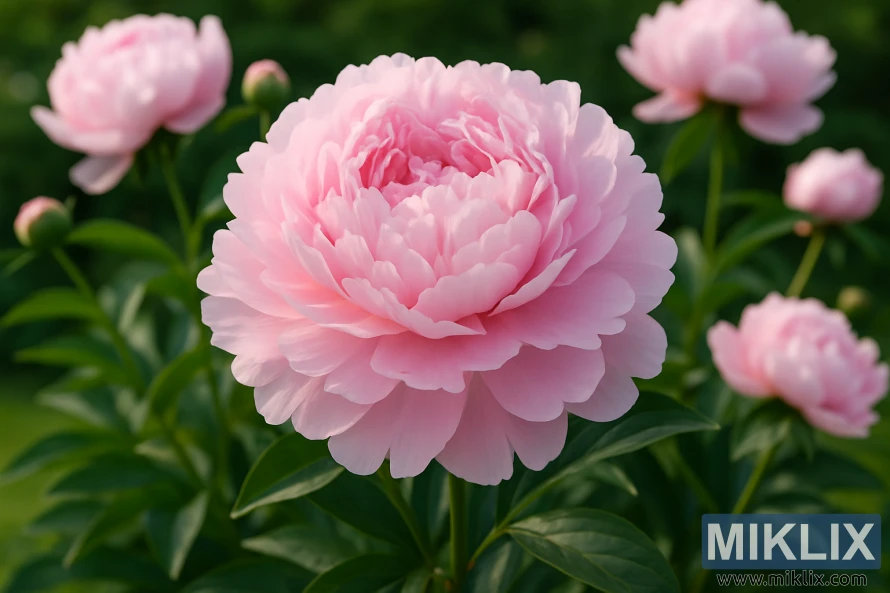
Festiva Maxima
A timeless white peony that has remained popular since 1851, 'Festiva Maxima' produces magnificent pure white blooms with occasional crimson flecks on the inner petals. This variety exemplifies the perfect balance of elegance and garden performance, with strong stems supporting the large, fragrant flowers.
- Bloom Time: Early to mid-season
- Fragrance: Strong, rose-like scent
- Height: 3-4 feet
- Flower Form: Double
- Hardiness Zones: 3-8
- Special Features: Historic variety with exceptional fragrance
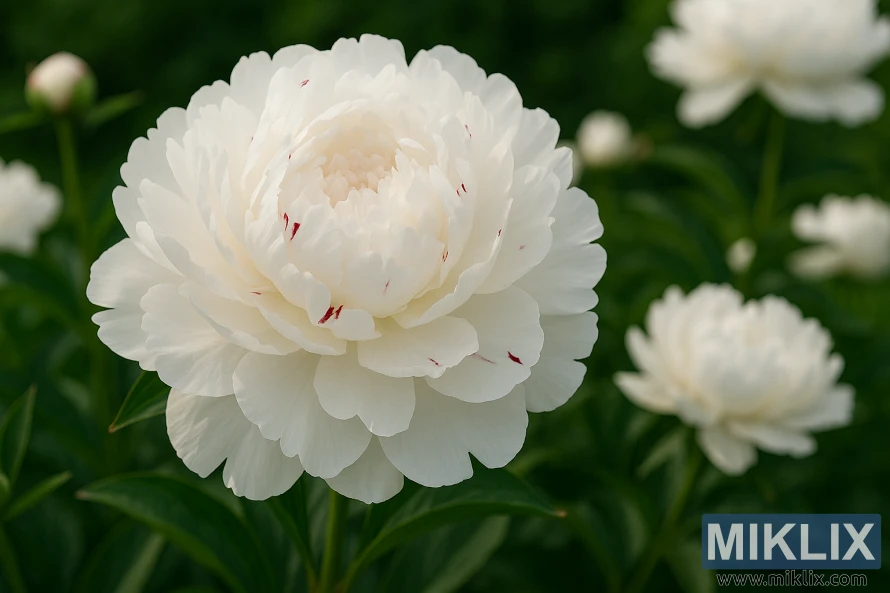
Red Charm
Widely considered the finest red peony available, 'Red Charm' produces spectacular deep red blooms in the classic "bomb" form. Large outer guard petals frame a densely packed center of smaller petals, creating a dramatic display that commands attention in any garden setting. The rich, velvety color holds well without fading, even in warm weather.
- Bloom Time: Early season
- Fragrance: Mild
- Height: 3 feet
- Flower Form: Bomb
- Hardiness Zones: 3-8
- Special Features: Award-winning variety with exceptional color retention
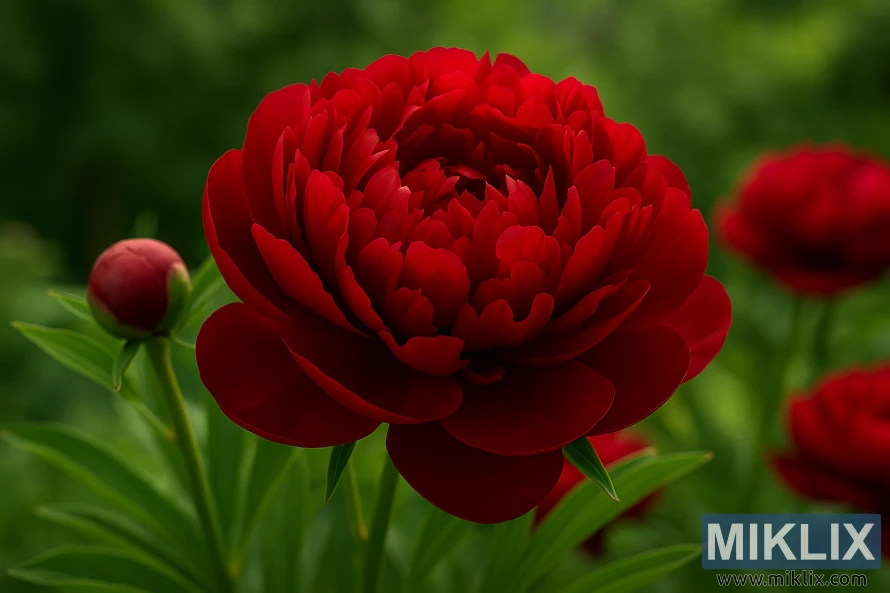
Coral Charm
This breathtaking peony opens as a vibrant coral-pink and gradually transforms to a soft peach as the bloom matures. The semi-double flowers with their golden centers create a tropical appearance that brings a unique color palette to the peony garden. 'Coral Charm' has won numerous awards for its outstanding beauty and garden performance.
- Bloom Time: Early to mid-season
- Fragrance: Light
- Height: 2-3 feet
- Flower Form: Semi-double
- Hardiness Zones: 3-8
- Special Features: Unique color-changing blooms
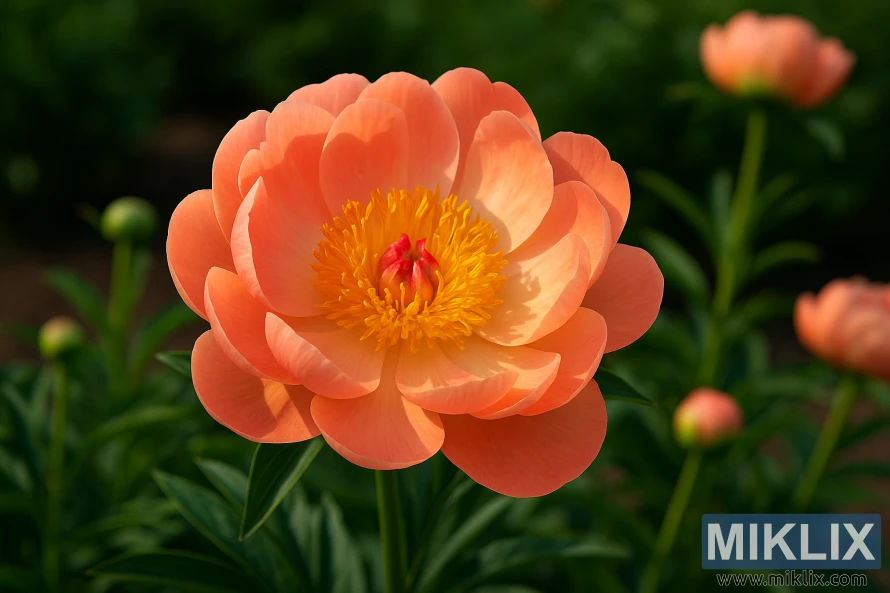
Most Beautiful Tree Peony Varieties
Tree peonies bring a different dimension to the garden with their woody structure and exceptionally large blooms. These long-lived shrubs create a dramatic focal point and offer colors not found in herbaceous types. Though they grow slowly, their patience-rewarding beauty makes them worth the wait.
High Noon
'High Noon' produces spectacular golden-yellow blooms that seem to glow in the garden. The large, semi-double flowers can reach 8-10 inches across and feature ruffled petals surrounding a center of dramatic stamens. This variety brings a rare and coveted color to the peony palette that's impossible to achieve with herbaceous types.
- Bloom Time: Mid-spring
- Fragrance: Light, pleasant
- Height: 4-5 feet
- Flower Form: Semi-double
- Hardiness Zones: 4-9
- Special Features: Rare yellow color, exceptionally large blooms
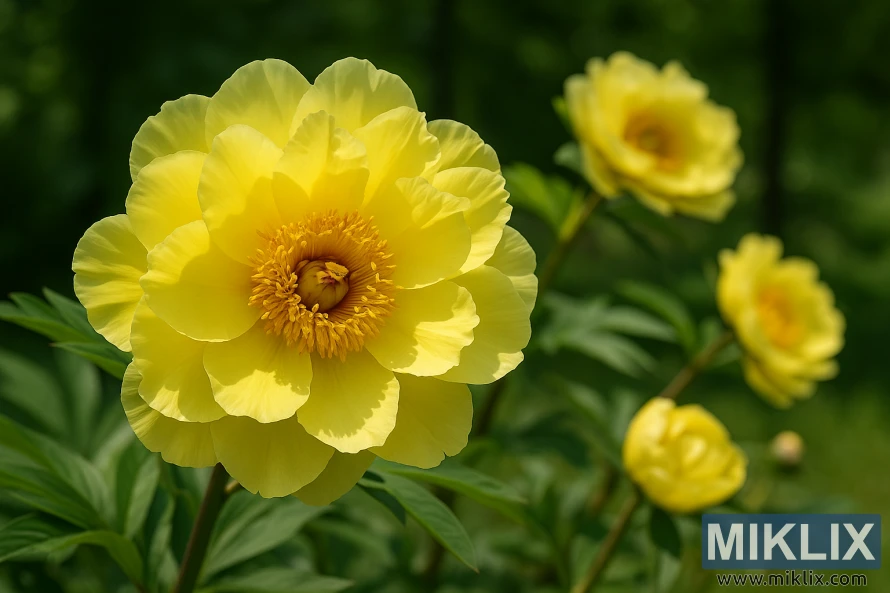
Shimadaijin
This Japanese variety produces stunning deep purple-red blooms that bring a regal presence to the garden. The large, semi-double to double flowers have a silky texture and slight ruffling that catches the light beautifully. 'Shimadaijin' is considered one of the finest purple tree peonies available and creates a striking contrast with yellow and white garden companions.
- Bloom Time: Mid-spring
- Fragrance: Light
- Height: 4-6 feet
- Flower Form: Semi-double to double
- Hardiness Zones: 4-9
- Special Features: Rare purple coloration, excellent garden performer
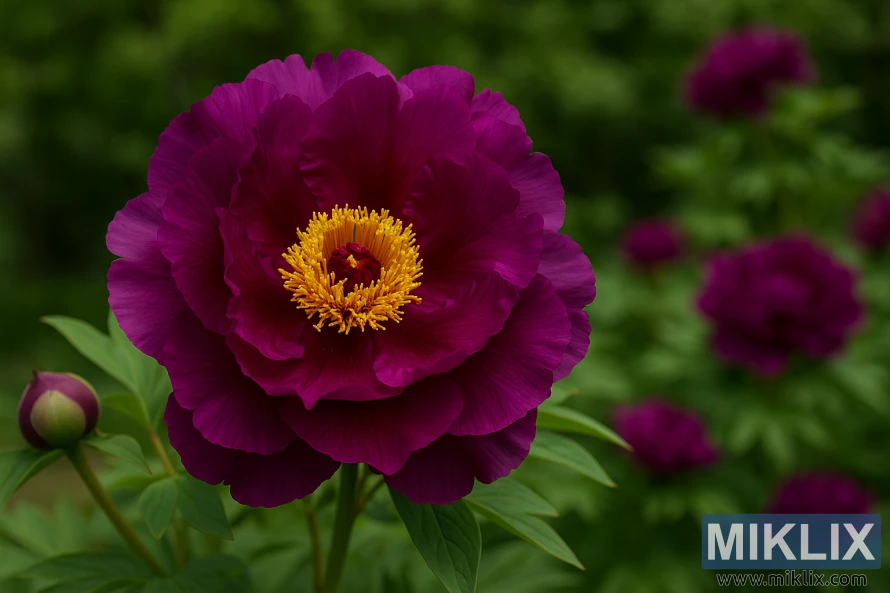
Most Beautiful Intersectional (Itoh) Peony Varieties
Intersectional peonies represent the best of both worlds, combining the magnificent flowers of tree peonies with the convenient growth habit of herbaceous types. These modern hybrids offer exceptional garden performance with strong stems that rarely need staking and an extended bloom period.
Bartzella
The most famous of all intersectional peonies, 'Bartzella' produces enormous lemon-yellow blooms that can reach 9-10 inches across. The semi-double to double flowers feature slightly ruffled petals with occasional red flares at the base. A mature plant can produce over 80 blooms in a single season, creating a spectacular display that lasts for weeks.
- Bloom Time: Mid to late season
- Fragrance: Strong, citrus scent
- Height: 3 feet
- Flower Form: Semi-double to double
- Hardiness Zones: 3-8
- Special Features: Exceptional bloom count, strong stems
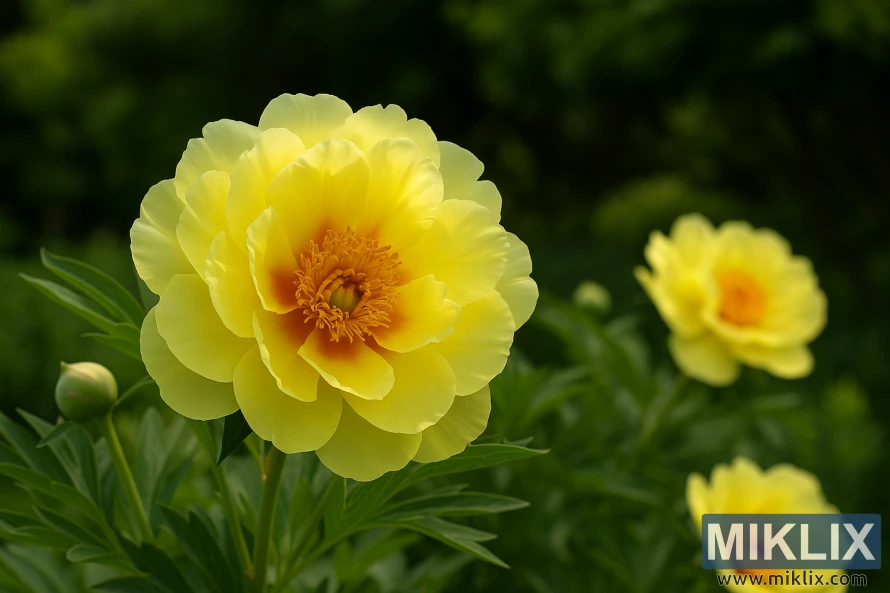
Cora Louise
'Cora Louise' produces exquisite white blooms with lavender-pink flares radiating from the center. The semi-double flowers have a delicate, airy quality with prominent yellow stamens that add to their charm. This variety combines elegance with remarkable garden performance, producing numerous blooms on strong, self-supporting stems.
- Bloom Time: Mid-season
- Fragrance: Light, sweet
- Height: 2.5-3 feet
- Flower Form: Semi-double
- Hardiness Zones: 3-8
- Special Features: Unique color pattern, excellent garden performer
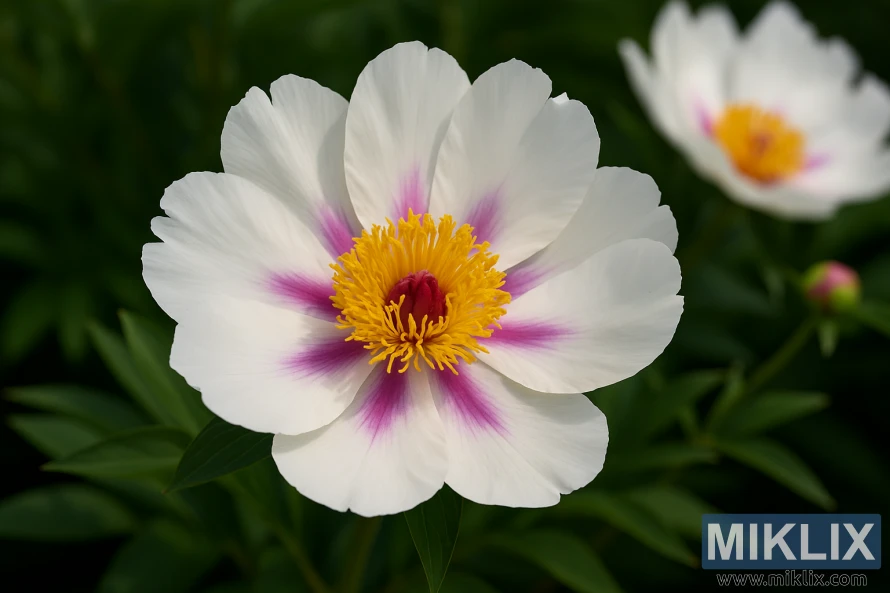
Essential Guide to Growing Beautiful Peony Varieties
Peonies are remarkably easy to grow when given the right conditions from the start. Follow these guidelines to ensure your peonies thrive and provide decades of beautiful blooms.
Proper planting depth is critical - eyes should be just 1-2 inches below soil surface
Planting Instructions
When to Plant
Fall is the ideal time to plant peonies, allowing them to establish roots before winter dormancy. In most regions, September through October provides the perfect planting window. Spring planting is possible but may delay blooming by a year.
Choosing the Right Location
Peonies thrive in full sun (6+ hours daily) but appreciate afternoon shade in hot climates. They need good air circulation to prevent fungal issues and well-draining soil to avoid root rot. Once established, peonies dislike being moved, so choose their location carefully.
Planting Depth
The most critical factor for successful peony growing is proper planting depth. For herbaceous and intersectional peonies, position the "eyes" (pink or red growth buds) just 1-2 inches below the soil surface. Planting too deeply is the most common reason for failure to bloom. Tree peonies should be planted with the graft union 4-6 inches below the soil.
Spacing
Allow 3-4 feet between herbaceous and intersectional peonies, and 4-5 feet for tree peonies. This spacing provides adequate air circulation and room for plants to reach their mature size.
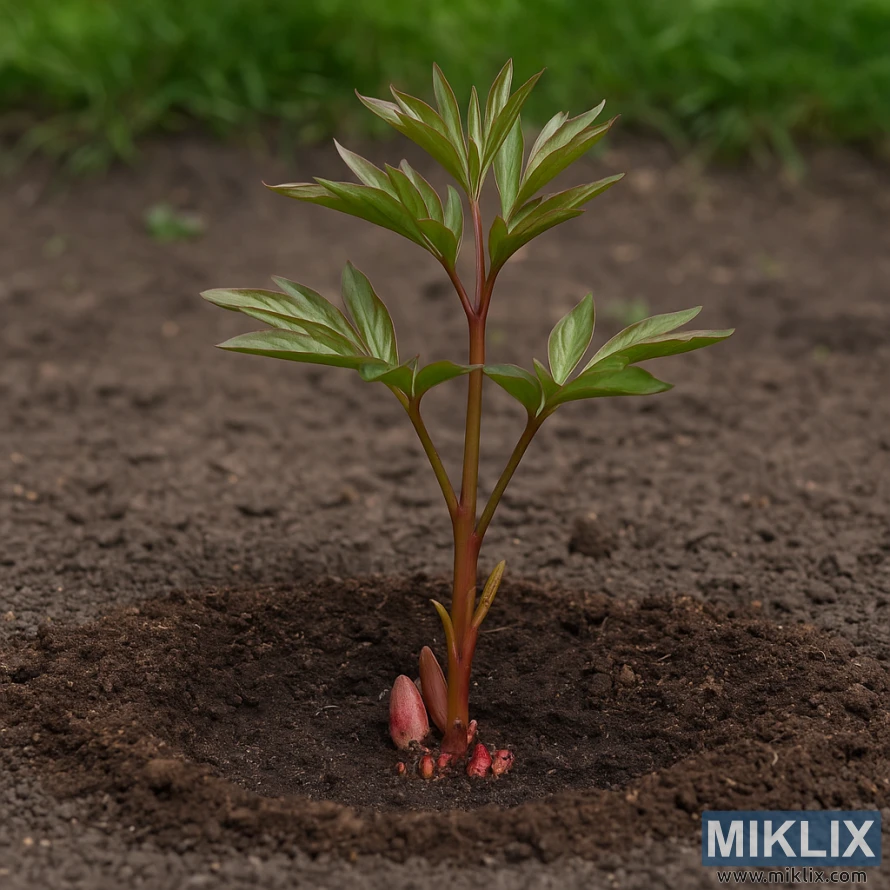
Soil and Fertilization
Soil Preparation
Peonies prefer slightly alkaline soil (pH 6.5-7.5) with good drainage. Before planting, amend the soil with compost and, if your soil is acidic, add a small amount of garden lime. Avoid high-nitrogen amendments as these can promote foliage at the expense of flowers.
Fertilization
Peonies are not heavy feeders. Apply a balanced, low-nitrogen fertilizer (like 5-10-10) in early spring as new growth emerges and again after flowering. Alternatively, top-dress with compost annually in the fall. Avoid high-nitrogen fertilizers, which can reduce flowering.
Watering and Maintenance
Watering
Water deeply but infrequently, allowing the soil to dry slightly between waterings. Newly planted peonies need consistent moisture their first year. Established plants are quite drought-tolerant but benefit from supplemental water during extended dry periods, especially when forming flower buds.
Mulching
Apply a 2-inch layer of organic mulch around plants, keeping it away from the stems to prevent rot. Mulch helps retain moisture, suppress weeds, and moderate soil temperature. Refresh mulch annually in spring.
Staking
Many herbaceous peonies, especially those with large double blooms, benefit from support to prevent stems from breaking during rain. Install peony rings or create your own support system in early spring when plants are just emerging.
Deadheading and Cleanup
Remove spent flowers to keep plants looking tidy and prevent seed formation, which diverts energy from root development. In fall, cut herbaceous and intersectional peony stems to ground level and dispose of the foliage to reduce disease pressure for the following year.
Common Pests and Diseases
Botrytis Blight
This fungal disease causes buds to turn brown and fail to open. Prevent by ensuring good air circulation, avoiding overhead watering, and removing all foliage in fall. If infection occurs, remove and dispose of affected parts and apply an organic fungicide.
Powdery Mildew
This appears as a white powdery coating on leaves, typically late in the season. While unsightly, it rarely threatens plant health. Improve air circulation and apply neem oil or a potassium bicarbonate spray if treatment is desired.
Ants
Ants are often seen on peony buds but are harmless and even beneficial, as they feed on the sweet nectar while protecting buds from other insects. There's no need to remove them; they'll leave once the flowers open.
Other Issues
Peonies are remarkably pest-resistant. Occasionally, they may suffer from leaf spots or Japanese beetles. Practice good garden hygiene and use organic controls as needed. Most healthy, established peonies will tolerate minor pest damage without significant impact.
Embracing the Beauty of Peonies in Your Garden
A mature peony garden offers weeks of spectacular blooms each spring
Few plants offer the combination of beauty, fragrance, and longevity that peonies bring to the garden. These magnificent perennials ask little but give abundantly, often outliving the gardeners who plant them. By selecting a variety of types and bloom times, you can create a peony display that unfolds over several weeks each spring, filling your garden with color and your home with fragrant cut flowers.
Whether you choose the classic charm of 'Sarah Bernhardt,' the regal presence of 'Red Charm,' or the modern innovation of 'Bartzella,' each peony brings its own unique character to the garden. Take the time to plant them properly, give them the minimal care they require, and you'll be rewarded with a lifetime of breathtaking blooms that improve with each passing year.
As you plan your peony collection, remember that patience is part of the journey. While most peonies will bloom lightly in their second year, they typically take three to four years to reach their full flowering potential. This patience is richly rewarded, as mature plants can produce dozens of blooms and remain productive for decades—truly making peonies one of the best investments a gardener can make.
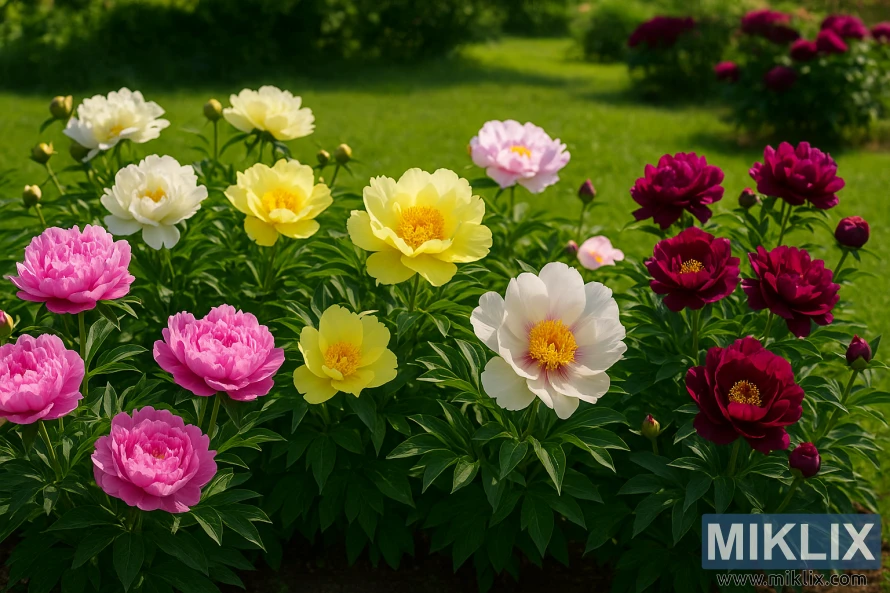
Further Reading
If you enjoyed this post, you may also like these suggestions:
- 12 Stunning Delphinium Varieties to Transform Your Garden
- Most Beautiful Hydrangea Varieties to Grow in Your Garden
- A Guide to the Most Beautiful Tulip Varieties for Your Garden
